Sustainable Development Goal 7
Sustainable Development Goal 7 (SDG 7 or Global Goal 7) is one of 17 Sustainable Development Goals established by the United Nations General Assembly in 2015. It aims to "Ensure access to affordable, reliable, sustainable and modern energy for all."[1] Access to energy is a very important pillar for the wellbeing of the people as well as economic development and poverty alleviation.[2]
| Sustainable Development Goal 7 | |
|---|---|
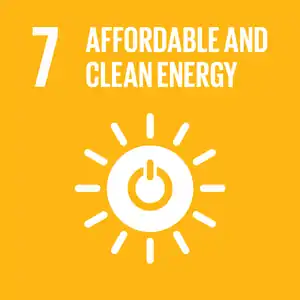 | |
| Mission statement | "Ensure access to affordable, reliable, sustainable and modern energy for all" |
| Commercial? | No |
| Type of project | Non-Profit |
| Location | Global |
| Owner | Supported by United Nations & Owned by community |
| Founder | United Nations |
| Established | 2015 |
| Website | sdgs |
The goal has five targets to be achieved by 2030.[2] Progress towards the targets is measured by six indicators.[2] Three out of the five targets are "outcome targets": Universal access to modern energy; increase global percentage of renewable energy; double the improvement in energy efficiency. The remaining two targets are "means of achieving targets": to promote access to research, technology and investments in clean energy; and expand and upgrade energy services for developing countries. In other words, these targets include access to affordable and reliable energy while increasing the share of renewable energy in the global energy mix. This would involve improving energy efficiency and enhancing international cooperation to facilitate more open access to clean energy technology and more investment in clean energy infrastructure. Plans call for particular attention to infrastructure support for the least developed countries, small islands and land-locked developing countries.[3]
According to a report in 2019, the world is making progress towards achieving SDG 7, but will fall short of meeting the targets by 2030 at the current rate of progress.[4] SDG 7 and Climate change mitigation (SDG 13) are closely related and complementary.[4]: 101 In order to achieve long term climate goals, the world needs to put more effort into renewable energy.
Background
Use of energy marks the beginning of human civilization. It began with the use of burning biomass (discovery of fire) to produce heat for local heating and cooking purposes. The Industrial Revolution in the late 1700s caused a paradigm shift to the use of coal, oil and natural gas as the primary sources of energy. As the population increased over the years, the demand for these non-renewable resources also increased many fold, thus pushing the environment to the brink of destruction.

As the world population continues to grow, so will the gap between those who can afford it and those who cannot. A representative at the UN High-level Political Forum on Sustainable Development stated that "despite improved access to electricity globally, nearly one billion people continue to live without electricity and three billion people lack access to clean cooking solutions and are exposed to dangerous levels of indoor air pollution".[5] At the same time, an economy reliant on fossil fuels is causing changes to our climate. Energy is central to nearly every major challenge and opportunity the world faces today, including for example adaptation to climate change, food security, health, education, sustainable cities, jobs and transport.[5] Hence, it is imperative that we move to more environment-friendly sources of energy, that are accessible by the most remote areas of the world.
Achieving SDG 7 is expected to galvanize actions to meet the Paris Agreement on climate change.[4]
Affordable, clean and modern Energy
For a long time, people have been using coal and oil as primary energy and to generate electricity.[6] Seeing the harm they have been doing to the environment countries all over the world are looking into other alternatives for energy production (renewable energy sources) such as:
- Solar Energy: This is energy derived from solar radiation. This is a very clean form of energy and can be used extensively due to its abundance. Technologies like photovoltaics, concentrated solar power and solar heating and cooling, are fast catching on to produce and supply energy even to places with no access to conventional fuels.[7]
- Wind Power: A clean, free, albeit intermittently available, form of energy, the kinetic energy possessed by moving winds can be captured to produce energy. Wind farms, consisting of a number of individual wind turbines, are installed at frequently windy sites.
- Geothermal Energy: Heat that comes from the sub-surface of the Earth can be tapped to produce energy. Geothermal power stations and heat pumps are used to capture the heat released from hot springs. This energy does not usually release any harmful emissions, and due to Earth's high heat capacity, can be easily replenished.
- Hydropower: This is the energy derived by tapping the kinetic energy of flowing water. By setting up turbines in rivers we can produce energy in a clean and emission-free way. Hydropower produces the most energy annually of the modern renewables
- Tidal Power: Energy from tidal forces can be tapped to generate electricity. Although not so commonly used, this clean and readily available source of energy has a great capacity as an alternative to conventional sources of energy.
- Biomass: Biomass can be burned and be used for energy production through direct firing, co-firing, pyrolysis, gasification and anaerobic decomposition.
- Nuclear Power: Using nuclear fission tremendous amounts of heat is generated in the reactor. Water is then used to cool the reactor which generates steam, the steam generated turns a steam turbine which generates electricity.
And while a shift to renewables has begun, it still contributes around 18% of the world's total energy consumption, with only about 10% coming from modern renewables.[8]
Targets, indicators and progress
SDG 7 has five targets, measured with five indicators, which are to be achieved by 2030. Three out of the five targets are "outcome targets", and two are "means of achieving targets".
Target 7.1: Universal access to modern energy
The first target of SDG 7 is Target 7.1: "By 2030, ensure universal access to affordable, reliable and modern energy services".[9]
This target has two indicators:[2]

- Indicator 7.1.1: Proportion of population with access to electricity
- Indicator 7.1.2: Proportion of population with primary reliance on clean fuels and technology. - The indicator is calculated as the number of people using clean fuels and technologies for cooking, heating and lighting divided by total population reporting that any cooking, heating or lighting, expressed as a percentage.[10] ("Clean fuel" in this context is defined by the emission rate targets and specific fuel recommendations (i.e. against unprocessed coal and kerosene) included in the normative guidance WHO guidelines for indoor air quality.)[10][11]

A report from 2019 found that:[4]
- Progress in expanding access to electricity was made in several countries, notably India, Bangladesh, and Kenya. The global population without access to electricity decreased to about 840 million in 2017 from 1.2 billion in 2010.
- Sub-Saharan Africa remains the region with the largest access deficit. Here, 573 million people—more than one in two—lack access to electricity.
- The population without access to clean cooking solutions totaled almost 3 billion in 2016 and was distributed across both Asia and Africa.
Key strategies for closing this gap will include private sector financing, versatile solutions that include decentralized renewables, and efforts to both extend rural electrification and cope with urban densification.[4]
Women are disproportionately affected by indoor air pollution caused by the use of fuels such as coal and wood indoors.[4] Barriers to the adoption of clean cooking solutions include their affordability, lack of supply, and social acceptability.[4]
According to the World Bank, 90 percent of the world's population had access to electricity as of 2018. It also noted that from the years 2010 to 2018, the global population without access to electricity went down from 1.2 billion to 789 million. An average of 136 million people had access to electricity between the years 2016 and 2018.[12] There are strong disparities among countries and regions. For example, countries that are least developed are lagging behind the global average.
Estimations note that 94% of the global population should have access to electricity by 2030, without taking into account the repercussions of COVID-19. Bringing electricity to unserved populations comes with difficulty including affordability, reliability and the cost of deploying final solutions.[12] This is particularly applicable in low income, remote or conflict-affected countries.[12]
Finance for energy access remains far below the investment needed to achieve SDG 7 by 2030: USD 41 billion of annual investment is required to achieve universal residential electrification, but only one third, or USD 16 billion, was tracked by Sustainable Energy for All in 20 high-impact countries in 2018. Finance for clean cooking tripled from USD 48 million in 2017 to USD 131 million in 2018 but remains substantially below the estimated annual USD 4.5 billion required to achieve universal access by 2030. With only marginal year-on-year increases in commitments for energy, it is becoming increasingly clear that the financing community is failing to deliver on SDG7.[13]
Target 7.2: Increase global percentage of renewable energy
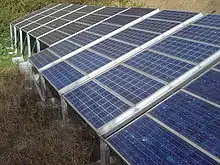
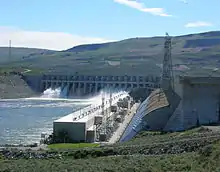
The second target of SDG 7 is Target 7.2: "By 2030, increase substantially the share of renewable energy in the global energy mix."[9]
It has only one indicator: Indicator 7.2.1 is the "Renewable energy share in the total final energy consumption".
Renewable energy accounted for 17.5% of global total energy consumption in 2016, 10.2% with biomass excluded.[4] Of the three end uses of renewables (electricity, heat, and transport) the use of renewables grew fastest with respect to electricity. This was driven by the expansion of wind and solar technologies.[4]
Renewables still face persistent financial, regulatory, and sometimes technological barriers.[4]

Target 7.3: Double the improvement in energy efficiency
The third target of SDG 7 is Target 7.3: "By 2030, double the global rate of improvement in energy efficiency".[9]
It has one indicator: Indicator 7.3.1 is the "Energy intensity measured in terms of primary energy and GDP".
Global primary energy intensity needs to drop from 5.6 megajoules (MJ) per USD in 2010 to 3.4 by 2030 to achieve the SDG 7.3 target. According to Tracking SDG7: The Energy Progress Report, the global primary energy intensity in 2018 was 4.75 MJ/USD (2017 PPP), after a 1.1 percent global annual improvement. This is well below the annual 2.6 percent initially projected as a prerequisite to reaching the target of SDG 7.3, which now requires an average annual rate of 3 percent every year from 2018 through 2030 to meet the goal.[14]
A report in 2019 found that energy efficiency improvements have increased steadily in recent years, thanks to concerted policy efforts in major economies, including China.[4]
Governments can increase this potential by strengthening mandatory energy efficiency policies, providing targeted fiscal or financial incentives, leveraging market-based mechanisms, and disseminating high-quality information about energy efficiency.[4]
Nuclear energy provides a proven solution to meet growing energy needs around the world in addition to being extremely energy-dense compared to other renewable energy sources.[15]
Target 7.a: Promote access to research, technology and investments in clean energy

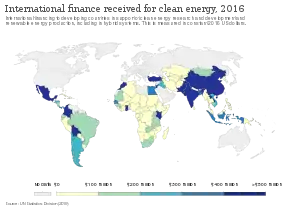
The fourth target of SDG 7 is Target 7.a: "By 2030, enhance international cooperation to facilitate access to clean energy research and technology, including renewable energy, energy efficiency and advanced and cleaner fossil-fuel technology, and promote investment in energy infrastructure and clean energy technology"[9]
It has one indicator: Indicator 7.4.1 is the "International financial flows to developing countries in support of clean energy research and development and renewable energy production, including in hybrid systems". A progress update by the United Nations in 2020 found that international financial flows to developing countries in support of clean and renewable energy reached $21.4 billion in 2017. This is a twofold increase from flows committed in 2010.[16] Hydropower projects received 46 per cent of 2017 flows, while solar projects received 19 per cent, wind 7 per cent and geothermal 6 per cent.[16]
Nuclear energy power generation requires the use of radioactive Uranium, which is not a renewable energy source and includes an extraction process that yields high carbon emissions. Whilst electricity generation is projected to increase globally from about 2.7 to 3.8 trillion kilowatt-hours from 2006 to 2030 particularly in large developing countries like India.[17] A solution to this can be found in the oceans with up to 4 billion tonnes of dissolved uranium present with a concentration of 3 mg of U/m3.[17] By implementing polymeric and inorganic materials, studies show the cost of uranium extraction can decrease from 1230 USD/kg to 350 USD/kg, due to these materials improving the efficiency of absorbent materials and thus the adsorption capacity.[18] By increasing investments and research into improvements to adsorption materials, we can decrease the cost per kilogram of seawater obtained from uranium whilst decreasing the higher emission terrestrial mining alternative.
Spatial and technological constraints associated with traditional nuclear plants have prevented developing countries from adopting nuclear energy. As such, compact nuclear reactors such as the FNBR (Fixed Bed Nuclear Reactor) have been developed, generating around 70 megawatts, composed of a pressurized light reactor having its fuel in spherical form.[19] The fuel consists of UO2 kernels within a Zr matrix which is then coated by an outer layer of Zr. These fuel elements are typically 15 mm in diameter, providing energy within a spatial constraint and serving a dual purpose as it can also be used as a desalinization plant making it suitable for developing countries.[19] In addition to reducing substrate deformation effects and decreasing nano hardness improving the overall efficiency of the reactor.[20]
Whilst other proposed reactor designs use molten salt technology which have high thermal efficiency, are smaller, and have 50% higher overall power generation compared to traditional nuclear reactor technology.[21]
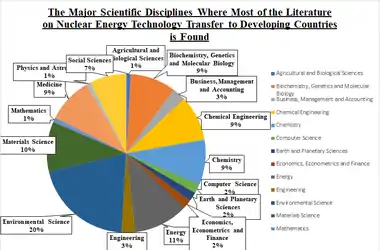
These innovative technologies created and perfected in industrialized countries with long histories of peaceful nuclear energy production can provide an impetus for private corporations to conduct technology transfer via energy subsidies, funded by developed countries.[22] Allowing responsible developing countries who foresee large energy demands and in the near future expect to build more nuclear plants with the possibility of a fully renewable, highly dense fuel source.
Target 7.b: Expand and upgrade energy services for developing countries
The fifth target of SDG 7 is formulated as: "Target 7.b: By 2030, expand infrastructure and upgrade technology for supplying modern and sustainable energy services for all in developing countries, in particular least developed countries, small island developing States, and land-locked developing countries, in accordance with their respective programs of support."[9]
It has one indicator: Indicator 7.5.1 is the "Investments in energy efficiency as a proportion of GDP and the amount of foreign direct investment in financial transfer for infrastructure and technology to sustainable development services".
As of August 2020, there is no data available for this indicator.[2]
It was reported in 2020 that Indicator 7.b.1 might be removed as it is identical with indicator 12.1.1 of SDG 12.[23]
Energy sector investment related to all SDG 7 targets will need to more than double in order to achieve these goals.[4] Between 2018 and 2030, the annual average investment will need to reach approximately $55 billion to expand energy access, about $700 billion to increase renewable energy and $600 billion to improve energy efficiency.[4]
Custodian agencies
Custodian agencies are in charge of reporting on the following indicators:[24][25]
- Indicators 7.1.1 and 7.1.2: World Bank (WB) and World Health Organization (WHO).
- Indicator 7.2.1: Department of Economic and Social Affairs-Statistics Division (DESA/UNDP), International Energy Agency (IEA) and International Renewable Energy Agency (IRENA).
- Indicator 7.3.1 are Department of Economic and Social Affairs-Statistics Division (DESA/UNDP) and International Energy Agency (IEA).
- Indicator 7.a.1: Organization for Economic Cooperation and Development (OECD) and International Renewable Energy Agency (IRENA).
- Indicator 7.b.1: International Energy Agency (IEA).
Overall progress and monitoring
The UN High-Level Political Forum on Sustainable Development (HLPF) meets every year for global monitoring of the SDGs, under the auspices of the United Nations economic and Social Council. High-level progress reports for all the SDGs are published by the United Nations Secretary General.[16][26][27]
In 2022, the renewable energy- generating capacity in developing countries has increased by 58% in renewable capacity per capita. However, the international financial flows to developing countries to support renewable energy was 24% lower than in 2018.[28] Despite having progress in 2019 to 2020, there has been recent global events such as the war in Ukraine has impacted global progress in renewable energy and decarbonization transition by having it at a halt or decreasing rather than increasing.
Despite progress, the world is in 2022 not on track to achieve SDG 7. The progress towards SDG 7 has not been faster due to the world entering its third year of COVID-19 along with the highest number of violent conflicts and with the war in Ukraine creating one of the largest refugee crises to happen.[27] There are still over 700 million people without access to electricity and about 2.4 billion cooking with harmful fuels that also are polluting the environment.[28] More efforts need to be exerted to improved use of renewable energy and energy efficiency faster. These events has had catastrophic effect the livelihoods of many people and though in 2021, as the global economy started to rebound, these chain of events and negative effects as caused the global economy and progress to SDG 7 and other SDGs to slow down.[29]
According to the 2020 SDG report, affordable and reliable energy is now needed more than ever, especially after the COVID-19 pandemic, to supply hospitals and health facilities as well as access to energy for students learning remotely.[30] It also noted that in Sub-Saharan Africa, deficits in electricity are increasingly concentrate. It is estimated that around 620 million people would still lack access to electricity if the world continues to move at the current pace.
To reach the targets of SDG 7, there should be an enhanced political commitment, long-term energy planning, more public and private financing as well as appropriate policies and incentives to deploy the use of new technologies.[12]
Challenges
Covid-19 pandemic
In 2020, the COVID-19 pandemic has highlighted the need for reliable and affordable electricity in health centers.[16] One quarter of the health facilities in a number of surveyed developing countries are not electrified, and another quarter has unscheduled outages.[16] Many companies also are finding that they have excess stock of some items. Storage management may require even more energy consumption.[31] During the crisis progress has been seen in some aspect of SDG7 such as improvement in energy efficiency, use of renewable energy and increased access to electricity to people.[32] Financial capital in third world countries for renewable energy are increasing.[33]
A study in Ontario showed that the electricity demand had declined 14% as of April 2020.[34] This could be because the global social distancing response has caused people to rely less on energy intensive forms of transportation, instead relying on telecommunication and virtual meetings for their jobs and needs. This could make it easier to make infrastructural changes to the energy industry, while people are less reliant.
During the Recession of 2008, China invested significantly in renewable energies, as economic shortcomings were highlighted. It is possible that COVID-19 could have the same effect on a worldwide scale (although the Great Recession's effect on climate change ended up being inconsequential in the fight against climate change). The COVID-19 pandemic has also vastly decreased prices of oil. While this might motivate companies to increase demand for oil, more likely, the unprofitable oil situation will cause corporations to relocate funding to renewable sources as opposed to oil.[31]
Links with other SDGs
The SDGs are all interlinked. Energy (or SDG 7) is central to nearly every major challenge and opportunity the world faces today: this includes poverty eradication (SDG 1), gender equality (SDG 5), adaptation to climate change (SDG 13), food security (SDG 2), health (SDG 3), education (SDG 4), sustainable cities (SDG 11), jobs (SDG 8) and transport (SDG 9).[5]
SDG 7 and climate mitigation (SDG 13) are closely related and complementary.[4] The leading sources of the greenhouse gas savings that countries need to focus on in order to realize their commitments under the Paris Agreement are switching fuels to renewable energy and enhancing end-use energy efficiency.
Low human development and unequal access to energy are directly related to each other. Energy is highly linked to poverty and inequality since clean energy access is essential for women's health, education and productive activities. This leads to reduced poverty rates poverty especially amongst women as they spend more time than men cooking and collecting water and fuel.[35]
According to UN Women, energy interventions that take into perspective women's needs have a significant impact on addressing gender equality and community energy poverty while also ensuring the equal participation of women in energy intervention that in turn benefits the society at large.[36]
The world's economy is highly dependent on energy and the transition to more sustainable energy systems will impact the socioeconomic resilience of communities.
Organizations
There are five custodian agencies for SDG 7 which together published the most recent Energy Progress Report in 2012:[12]
- International Energy Agency (IEA)
- Department of Economic and Social Affairs-Statistics Division (DESA/UNDP)
- International Renewable Energy Agency (IRENA)
- United Nations Statistics Division (UNSD)
- World Bank (WB)
- World Health Organization (WHO)
- Organization for Economic Cooperation and Development (OECD)
US Based Organizations
In the US there are over two thousand tax-exempt organizations working on issues related to UN SDG 7, according to data filed with the Internal Revenue Service –IRS and aggregated by X4Impact.[37] X4Impact, with the support of the Rockefeller Foundation, Ford Foundation,[38] Hewlett Foundation,[39] and Giving Tech Labs, created a free online interactive tool Affordable and Clean Energy in the US. This online tool enables users to see energy-related indicators nationally and by state, as well as relevant information for over two thousand tax-exempt organizations in the US working on issues related to UN SDG 7. The nonprofit data in the tool is updated every 15 days while the indicators are updated annually.
See also
- Sustainable Energy for All
References
- United Nations (2015) Resolution adopted by the General Assembly on 25 September 2015, Transforming our world: the 2030 Agenda for Sustainable Development (A/RES/70/1)
- Ritchie, Roser, Mispy, Ortiz-Ospina (2018) "Measuring progress towards the Sustainable Development Goals." (SDG 7) SDG-Tracker.org, website
- "Goal 7: Affordable and clean energy". UNDP. Archived from the original on 7 September 2018. Retrieved 28 September 2015.
- IEA, IRENA, UNSD, WB, WHO (2019), Tracking SDG 7: The Energy Progress Report 2019, Washington DC (on Tracking SDG 7 website)
- United Nations (11 July 2018). "Achieving targets on energy helps meet other Global Goals, UN forum told". United Nations Sustainable Development. Retrieved 26 August 2020.
- "Total energy supply (TES) by source, World 1990-2018". Data and Statistics-IEA.
- "Solar Photovoltaic Materials". DuPont Photovoltaic Solutions.
- "Renewable share (modern renewables) in final energy consumption (SDG 7.2), World 1990-2017". Data and Statistics-IEA.
- United Nations (2017) Resolution adopted by the General Assembly on 6 July 2017, Work of the Statistical Commission pertaining to the 2030 Agenda for Sustainable Development (A/RES/71/313)
- UN Statistics (2016) Goal 7 Ensure access to affordable, reliable, sustainable and modern energy for all (Updated on 30 March 2016)
- WHO (2014) WHO indoor air quality guidelines: household fuel combustion, World Health Organization, Geneva.
- IEA, IRENA, UNSD, World Bank, WHO (2020) Tracking SDG 7: The Energy Progress Report. World Bank, Washington DC
- "Energizing Finance: Understanding the Landscape 2020". Sustainable Energy for All | SEforALL. Retrieved 2021-04-28.
- Sustainable Energy for All: SDG 7.3 - Energy Efficiency
- Lin, Mu-Xing; Liou, Hwa Meei; Chou, Kuei Tien (2020-03-16). "National Energy Transition Framework toward SDG7 with Legal Reforms and Policy Bundles: The Case of Taiwan and Its Comparison with Japan". Energies. 13 (6): 1387. doi:10.3390/en13061387. ISSN 1996-1073.
- United Nations Economic and Social Council (2020) Progress towards the Sustainable Development Goals Report of the Secretary-General, High-level political forum on sustainable development, convened under the auspices of the Economic and Social Council (E/2020/57), 28 April 2020
- Adamantiades, A.; Kessides, I. (2009-12-01). "Nuclear power for sustainable development: Current status and future prospects". Energy Policy. 37 (12): 5149–5166. doi:10.1016/j.enpol.2009.07.052. ISSN 0301-4215.
- Kim, Jungseung; Tsouris, Costas; Mayes, Richard T.; Oyola, Yatsandra; Saito, Tomonori; Janke, Christopher J.; Dai, Sheng; Schneider, Erich; Sachde, Darshan (2013-01-01). "Recovery of Uranium from Seawater: A Review of Current Status and Future Research Needs". Separation Science and Technology. 48 (3): 367–387. doi:10.1080/01496395.2012.712599. ISSN 0149-6395. OSTI 1062599. S2CID 96406828.
- Şahin, Sümer; Şahin, Hacı Mehmet; Al-Kusayer, Tawfik Ahmed; Sefidvash, Farhang (2011). "An innovative nuclear reactor for electricity and desalination". International Journal of Energy Research. 35 (2): 96–102. doi:10.1002/er.1772. ISSN 1099-114X. S2CID 110004502.
- Yeom, Hwasung; Dabney, Tyler; Johnson, Greg; Maier, Benjamin; Lenling, Mia; Sridharan, Kumar (2019-02-01). "Improving deposition efficiency in cold spraying chromium coatings by powder annealing". The International Journal of Advanced Manufacturing Technology. 100 (5): 1373–1382. doi:10.1007/s00170-018-2784-1. ISSN 1433-3015. S2CID 115154878.
- Inc, Terrestrial Energy (2021-11-08). "Choosing Canadian Generation IV SMR Would Reward Ontario with Once-in-a-Generation Economic Windfall: Hatch Study". GlobeNewswire News Room. Retrieved 2021-12-18.
- Kaartemo, Valtteri; Gonzalez-Perez, Maria Alejandra (2020-01-01). "Renewable energy in international business". Critical Perspectives on International Business. 16 (4): 325–336. doi:10.1108/cpoib-08-2019-0062. ISSN 1742-2043. S2CID 225621867.
- "IAEG-SDGs 2020 Comprehensive Review Proposals Submitted to the 51st session of the United Nations Statistical Commission for its consideration". United Nations, Department of Economic and Social Affairs, Statistics Division. Retrieved 1 September 2020.
- "SDG Indicators — SDG Indicators". unstats.un.org. Retrieved 2020-09-26.
- "United Nations (2018) Economic and Social Council, Conference of European Statisticians, Geneva," (PDF). United Nations (SDG 16) Custodian Agencies" (PDF). UNECE. Retrieved September 24, 2020.
- United Nations Economic and Social Council (2019) Special edition: progress towards the Sustainable Development Goals, Report of the Secretary-General (E/2019/68), High-level political forum on sustainable development, convened under the auspices of the Economic and Social Council (8 May 2019)
- United Nations: Economic and Social Council (2022). "Progress towards the Sustainable Development Goals" (PDF). High-level Political Forum on Sustainable Development: 29.
- "Goal 7 | Department of Economic and Social Affairs". sdgs.un.org. Retrieved 2022-05-30.
- Tucho, Gudina Terefe; Kumsa, Diribe Makonene (2020). "Challenges of Achieving Sustainable Development Goal 7 From the Perspectives of Access to Modern Cooking Energy in Developing Countries". Frontiers in Energy Research. 8. doi:10.3389/fenrg.2020.564104. ISSN 2296-598X.
- "The Sustainable Development Goals Report" (PDF). The United Nations Statistics Division. 2020.
- Sarkis, Joseph; Cohen, Maurie J.; Dewick, Paul; Schröder, Patrick (August 2020). "A brave new world: Lessons from the COVID-19 pandemic for transitioning to sustainable supply and production". Resources, Conservation, and Recycling. 159: 104894. doi:10.1016/j.resconrec.2020.104894. ISSN 0921-3449. PMC 7164912. PMID 32313383.
- "COVID-19 Intensifies the Urgency to Expand Sustainable Energy Solutions Worldwide".
- "The sustainable development goals report 2020" (PDF).
- Abu-Rayash, Azzam (October 2020). "Analysis of the electricity demand trends amidst the COVID-19 coronavirus pandemic". Energy Research and Social Science. 68: 101682. doi:10.1016/j.erss.2020.101682. PMC 7331303. PMID 32839701.
- "Policy Brief in support of the first SDG 7 review at the UN High-Level Political Forum 2018" (PDF). United Nations Department of Economic and Social Affairs. 2018.
- "Leveraging co-benefits between gender equality and climate action for sustainable development" (PDF). Report. 2016.
- "Press Release: X4Impact, a Market Intelligence Platform for Social Innovation, Announced U.S. Launch During the 2020 Un General Assembly - NextBillion". nextbillion.net. Retrieved 2021-11-17.
- X4Impact. "Ford Foundation Fuels Tech for the Public Interest with X4Impact". www.prnewswire.com. Retrieved 2021-11-17.
- "Press Release: Hewlett Foundation Becomes X4Impact Founding Partner to Advance Technology for the Public Interest With Focus on Entrepreneurs Creating Tech for Good Solutions - NextBillion". nextbillion.net. Retrieved 2021-11-17.
External links
- Sustainable Development Knowledge Platform (SDG 7)
- Energypedia - collaborative knowledge exchange on various energy topics in developing countries
- Understanding SDG 7
- “Global Goals” Campaign - SDG 7
- SDG-Track.org - SDG 7
- UN SDG 7 in the US
